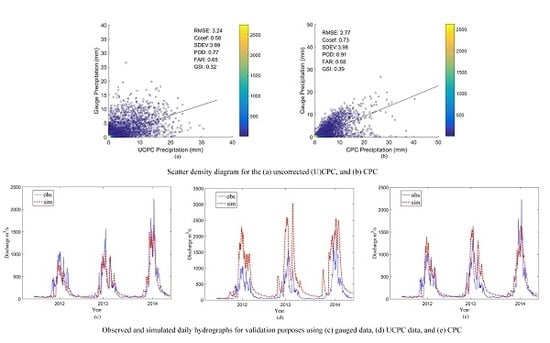Assessment and Correction of the PERSIANN-CDR Product in the Yarlung Zangbo River Basin, China
Abstract
1. Introduction
2. Materials and Methods
2.1. Study Area and Gauged Data
2.2. PERSIANN-CDR
2.3. Evaluation Indicators
2.4. Bias Correction
- Determining the initial field: The initial field of the precipitation data to be corrected is extracted from the SPE data. In this study, the rectangular range [L, W] of the study area was determined, and the satellite precipitation grid data in this range was the initial field Γ0. When the precipitation field is corrected, the position of the meteorological stations may not match with the SPE grid data. In this study, the bilinear interpolation method was used to obtain the precipitation satellite data value at the station position.
- Determining the interpolation function: The initial field Γ0, obtained from the PERSIANN-CDR grid, was calculated based on the difference between the measured value Mk of the kth gauged station and the value Γ0k at the same position. The first-guess field Γ1 was obtained by interpolating the difference into the initial field using the weighting function, and then repeating the above steps with Γ1 as the initial field until the difference was sufficiently small:where Γ1 is the first-guess value at the position of the grid coordinates (i,j) of the first-guess field, Γ0 represents the initial value at the position (i,j) of the initial field, Mk is the observed value at the kth gauged station, Γ0k represents the initial SPE value at the position of the kth gauged station, and Wijk is the weighting factor, which ranges from 0 to 1. The number of gauged stations in the search radius is given by k.
- Determining the weighting function: The weighting function Wijk has different forms (e.g., circle, ellipse, and curvature ellipse). In this study, the circular form was chosen as the weighting function:where R indicates the search radius with a value of 2°. The length of the grid (i,j) to the kth station is represented by dijk.
2.5. IHACRES Rainfall Runoff Model
Model Performance Evaluation
3. Results
3.1. Accuracy Assessment for the Original SPE Product
3.1.1. Basic Statistical Indices
3.1.2. Probabilistic Statistical Indices
3.2. Accuracy Assessment for the Corrected SPE Product
3.3. Discharge Simulation with Gauged Data, Uncorrected SPE Data, and Corrected SPE Data
4. Discussion
4.1. Effect of Temporal Resolution on the Accuracy of Corrected and Uncorrected SPEs
4.2. Effect of Spatial Resolution on the Accuracy of Original and Uncorrected SPEs
4.3. Assessment of Extreme Storm Events by the Corrected SPE Product Data
5. Conclusions
- The correlation between the uncorrected SPE data and gauged observation data was low on a daily scale, and the deviation was large. The original PERSIANN-CDR data could detect precipitation events to a certain extent, but 23% of the precipitation events were not captured, and 65% of the precipitation events were missed. The accuracy of the SPE product decreased gradually from the east to the west of the basin.
- The precipitation satellite data corrected by the SC method using one step showed a clear improvement at the daily scale, as well as a notable bias range convergence. The Ccoef increased from 0.58 to 0.73, and the values of SDEV and RMSE declined. The CPC product data moved toward the direction of the fitting curve, especially in the case of light precipitation. The overestimation by satellite precipitation data of the gauged data was reduced. The POD value of the corrected SPE product was 18.2% higher than the uncorrected SPE product, which indicated that the capability of detecting precipitation events improved. The SC method mainly improved the accuracy of the SPE product in the central and western regions of the basin.
- The temporal-spatial resolution influenced the performance of the SPE product in the Yarlung Zangbo River basin. When the temporal resolution changed from day to month and season, the values of statistical indices greatly improved, especially on the monthly scale. The SC method was not sensitive to the time scale, and the variations of the indices before and after correction on the monthly and seasonal scales were not obvious (except the variation of the correlation coefficient on the seasonal scale). With a change in the spatial resolution of the SPE data through downscaling and upscaling, only the corrected data were sensitive to the correlation coefficient. As the resolution became coarser, the correlation coefficient between the corrected SPE data and the ground station data gradually became lower.
- The IHACRES Model was calibrated using the SCE-UA algorithm and could be satisfactorily applied in the Lhasa River basin. The NSE values for models driven by gauged, UCPC, and CPC data were 0.816, −1.673, and 0.702, respectively. The UCPC product provided poor runoff simulations, while the CPC product provided greatly improved runoff simulations. The corrected product data were sufficiently accurate to fit the trend of the debris flow disaster in the Lhasa river in mid-to-late July 2014, which plays a very important role in flood disaster monitoring and prevention.
Author Contributions
Funding
Acknowledgments
Conflicts of Interest
Glossary
| Ccoef | Correlation Coefficient |
| CPC | Corrected PERSIANN-CDR |
| GPCP | Global Precipitation Climatology Project |
| SC | Successive correction |
| SPE | Satellite-based precipitation estimate |
| HE | Hydrological evaluation |
| IHACRES | Identification of unit Hydrographs and Component flows from Rainfall, Evapotranspiration, and Streamflow data |
| IR | Infrared |
| MW | Microwave |
| NSE | Nash–Sutcliffe coefficient of efficiency |
| PBIAS | Percent bias |
| PERSIANN-CDR | Precipitation Estimation from Remotely Sensed Information using Artificial Neural Networks-Climate Data Record |
| RMSE | Root mean square error |
| SDEV | Standard deviation |
| UCPC | Uncorrected PERSIANN-CDR |
| VIS | Visible |
References
- Xu, Z.X.; Takeuchi, K.; Ishidaira, H.; Li, J.Y. Long-term trend analysis for precipitation in Asian Pacific FRIEND river basins. Hydrol. Process. Int. J. 2005, 19, 3517–3532. [Google Scholar] [CrossRef]
- Xu, Z.X.; Gong, T.L.; Li, J.Y. Decadal trend of climate in the Tibetan Plateau—Regional temperature and precipitation. Hydrol. Process. Int. J. 2008, 22, 3056–3065. [Google Scholar] [CrossRef]
- Chen, C.; Chen, Q.; Duan, Z.; Zhang, J.; Mo, K.; Li, Z.; Tang, G. Multiscale comparative evaluation of the GPM IMERG v5 and TRMM 3B42 v7 precipitation products from 2015 to 2017 over a climate transition area of China. Remote Sens. 2018, 10, 944. [Google Scholar] [CrossRef]
- Satgé, F.; Xavier, A.; Pillco Zolá, R.; Hussain, Y.; Timouk, F.; Garnier, J.; Bonnet, M.-P. Comparative assessments of the latest GPM mission’s spatially enhanced satellite rainfall products over the main Bolivian watersheds. Remote Sens. 2017, 9, 369. [Google Scholar] [CrossRef]
- Souza, A.G.S.S.; Neto, A.R.; Rossato, L.; Alvalá, R.C.S.; Souza, L.L. Use of SMOS L3 soil moisture data: Validation and drought assessment for Pernambuco State, Northeast Brazil. Remote Sens. 2018, 10, 1314. [Google Scholar] [CrossRef]
- Su, J.; Lü, H.; Wang, J.; Sadeghi, A.M.; Zhu, Y. Evaluating the applicability of four latest satellite–gauge combined precipitation estimates for extreme precipitation and streamflow predictions over the upper Yellow River basins in China. Remote Sens. 2017, 9, 1176. [Google Scholar] [CrossRef]
- Bellerby, T.J.; Sun, J. Probabilistic and ensemble representations of the uncertainty in an IR/microwave satellite precipitation product. J. Hydrometeorol. 2005, 6, 1032–1044. [Google Scholar] [CrossRef]
- Bitew, M.M.; Gebremichael, M. Assessment of satellite rainfall products for streamflow simulation in medium watersheds of the Ethiopian highlands. Hydrol. Earth Syst. Sci. 2011, 15, 1147–1155. [Google Scholar] [CrossRef]
- Bitew, M.M.; Gebremichael, M. Evaluation of satellite rainfall products through hydrologic simulation in a fully distributed hydrologic model. Water Resour. Res. 2011, 47, 1–11. [Google Scholar] [CrossRef]
- Benjamin, S.O.; Seaman, N.L. A simple scheme for objective analysis in curved flow. Mon. Weather Rev. 1985, 113, 1184–1198. [Google Scholar] [CrossRef]
- Behrangi, A.; Khakbaz, B.; Jaw, T.C.; AghaKouchak, A.; Hsu, K.; Sorooshian, S. Hydrologic evaluation of satellite precipitation products over a mid-size basin. J. Hydrol. 2011, 397, 225–237. [Google Scholar] [CrossRef]
- Tong, K.; Su, F.; Yang, D.; Hao, Z. Evaluation of satellite precipitation retrievals and their potential utilities in hydrologic modeling over the Tibetan Plateau. J. Hydrol. 2014, 519, 423–437. [Google Scholar] [CrossRef]
- Hou, A.Y.; Kakar, R.K.; Neeck, S.; Azarbarzin, A.A.; Kummerow, C.D.; Kojima, M.; Oki, R.; Nakamura, K.; Iguchi, T. The global precipitation measurement mission. Bull. Am. Meteorol. Soc. 2014, 95, 701–722. [Google Scholar] [CrossRef]
- Ma, Y.; Yang, Y.; Han, Z.; Tang, G.; Maguire, L.; Chu, Z.; Hong, Y. Comprehensive evaluation of ensemble multi-satellite precipitation dataset using the dynamic bayesian model averaging scheme over the Tibetan Plateau. J. Hydrol. 2018, 556, 634–644. [Google Scholar] [CrossRef]
- Huffman, G.J.; Bolvin, D.T.; Nelkin, E.J.; Wolff, D.B.; Adler, R.F.; Gu, G.; Hong, Y.; Bowman, K.P.; Stocker, E.F. The TRMM multisatellite precipitation analysis (TMPA): Quasi-global, multiyear, combined-sensor precipitation estimates at fine scales. J. Hydrometeorol. 2007, 8, 38–55. [Google Scholar] [CrossRef]
- Funk, C.; Peterson, P.; Landsfeld, M.; Pedreros, D.; Verdin, J.; Shukla, S.; Husak, G.; Rowland, J.; Harrison, L.; Hoell, A.; et al. The climate hazards infrared precipitation with stations—A new environmental record for monitoring extremes. Sci. Data 2015, 2, 150066. [Google Scholar] [CrossRef] [PubMed]
- Omranian, E.; Sharif, H.O. Evaluation of the global precipitation measurement (GPM) satellite rainfall products over the lower Colorado River basin, Texas. J. Am. Water Resour. Assoc. 2018, 54, 882–898. [Google Scholar] [CrossRef]
- Sorooshian, S.; Hsu, K.L.; Gao, X.; Gupta, H.V.; Imam, B.; Braithwaite, D. Evaluation of PERSIANN system satellite-based estimates of tropical rainfall. Bull. Am. Meteorol. Soc. 2000, 81, 2035–2046. [Google Scholar] [CrossRef]
- Ashouri, H.; Hsu, K.L.; Sorooshian, S.; Braithwaite, D.K.; Knapp, K.R.; Cecil, L.D.; Nelson, B.R.; Prat, O.P. PERSIANN-CDR: Daily precipitation climate data record from multisatellite observations for hydrological and climate studies. Bull. Am. Meteorol. Soc. 2015, 96, 69–83. [Google Scholar] [CrossRef]
- Jiang, S.; Ren, L.; Hong, Y.; Yong, B.; Yang, X.; Yuan, F.; Ma, M. Comprehensive evaluation of multi-satellite precipitation products with a dense rain gauge network and optimally merging their simulated hydrological flows using the Bayesian model averaging method. J. Hydrol. 2012, 452, 213–225. [Google Scholar] [CrossRef]
- Hirpa, F.A.; Mekonnen, G.; Hopson, T. Evaluation of high-resolution satellite precipitation products over very complex terrain in Ethiopia. J. Appl. Meteorol. Climatol. 2010, 49, 1044–1051. [Google Scholar] [CrossRef]
- Chen, M.; Xie, P.; Janowiak, J.E.; Arkin, P.A. Global land precipitation: A 50-yr monthly analysis based on gauge observations. J. Hydrometeorol. 2002, 3, 249–266. [Google Scholar] [CrossRef]
- Terink, W.; Hurkmans, R.T.W.L.; Torfs, P.J.J.F.; Uijlenhoet, R. Evaluation of a bias correction method applied to downscaled precipitation and temperature reanalysis data for the Rhine basin. Hydrol. Earth Syst. Sci. 2010, 14, 687–703. [Google Scholar] [CrossRef]
- Habib, E.; Haile, A.T.; Sazib, N.; Zhang, Y.; Rientjes, T. Effect of bias correction of satellite-rainfall estimates on runoff simulations at the source of the upper Blue Nile. Remote Sens. 2014, 6, 6688–6708. [Google Scholar] [CrossRef]
- Bhatti, H.A.; Rientjes, T.; Haile, A.T.; Habib, E.; Verhoef, W. Evaluation of bias correction method for satellite-based rainfall data. Sensors 2016, 16, 884. [Google Scholar] [CrossRef] [PubMed]
- Worqlul, A.W.; Ayana, E.K.; Maathuis, B.H.; MacAlister, C.; Philpot, W.D.; Leyton, J.M.O.; Steenhuis, T.S. Performance of bias corrected MPEG rainfall estimate for rainfall-runoff simulation in the upper Blue Nile Basin, Ethiopia. J. Hydrol. 2018, 556, 1182–1191. [Google Scholar] [CrossRef]
- Poméon, T.; Jackisch, D.; Diekkrüger, B. Evaluating the performance of remotely sensed and reanalysed precipitation data over West Africa using HBV light. J. Hydrol. 2017, 547, 222–235. [Google Scholar] [CrossRef]
- Thiemig, V.; Rojas, R.; Zambrano-Bigiarini, M.; De Roo, A. Hydrological evaluation of satellite-based rainfall estimates over the Volta and Baro-Akobo basin. J. Hydrol. 2013, 499, 324–338. [Google Scholar] [CrossRef]
- Jakeman, A.J.; Littlewood, I.G.; Whitehead, P.G. Computation of the instantaneous unit hydrograph and identifiable component flows with application to two small upland catchments. J. Hydrol. 1990, 117, 275–300. [Google Scholar] [CrossRef]
- Dye, P.J.; Croke, B.F. Evaluation of streamflow predictions by the IHACRES rainfall-runoff model in two South African catchments. Environ. Model. Softw. 2003, 18, 705–712. [Google Scholar] [CrossRef]
- Oyerinde, G.T.; Hountondji, F.C.; Lawin, A.E.; Odofin, A.J.; Afouda, A.; Diekkrüger, B. Improving hydro-climatic projections with bias-correction in Sahelian Niger basin, West Africa. Climate 2017, 5, 8. [Google Scholar] [CrossRef]
- Liu, G.; He, Z.; Luan, Z.; Qi, S. Intercomparison of a lumped model and a distributed model for streamflow simulation in the Naoli River watershed, Northeast China. Water 2018, 10, 1004. [Google Scholar] [CrossRef]
- AghaKouchak, A.; Mehran, A. Extended contingency table: Performance metrics for satellite observations and climate model simulations. Water Resour. Res. 2013, 49, 7144–7149. [Google Scholar] [CrossRef]
- Duan, Q.Y.; Gupta, V.K.; Sorooshian, S. Shuffled complex evolution approach for effective and efficient global minimization. J. Optim. Theory Appl. 1993, 76, 501–521. [Google Scholar] [CrossRef]
- Chu, W.; Gao, X.; Sorooshian, S. A new evolutionary search strategy for global optimization of high-dimensional problems. Inf. Sci. 2011, 181, 4909–4927. [Google Scholar] [CrossRef]
- Perrin, C. Vers Une Amélioration d’un Modèle Global Pluie-Débit au Travers d’une Approche Comparative. Ph.D. Thesis, Institut National Polytechnique De Grenoble, Grenoble, France, October 2000; 530p. [Google Scholar]
- Nash, J.E.; Sutcliffe, J.V. River flow forecasting through conceptual models part I—A discussion of principles. J. Hydrol. 1970, 10, 282–290. [Google Scholar] [CrossRef]
- Moriasi, D.N.; Arnold, J.G.; Van Liew, M.W.; Bingner, R.L.; Harmel, R.D.; Veith, T.L. Model evaluation guidelines for systematic quantification of accuracy in watershed simulations. Trans. ASABE 2007, 50, 885–900. [Google Scholar] [CrossRef]
- Taylor, K.E. Summarizing multiple aspects of model performance in a single diagram. J. Geophys. Res.-Atmos. 2001, 106, 7183–7192. [Google Scholar] [CrossRef]
- Omranian, E.; Sharif, H.; Tavakoly, A. How well can global precipitation measurement (GPM) capture hurricanes? Case study: Hurricane Harvey. Remote Sens. 2018, 10, 1150. [Google Scholar] [CrossRef]
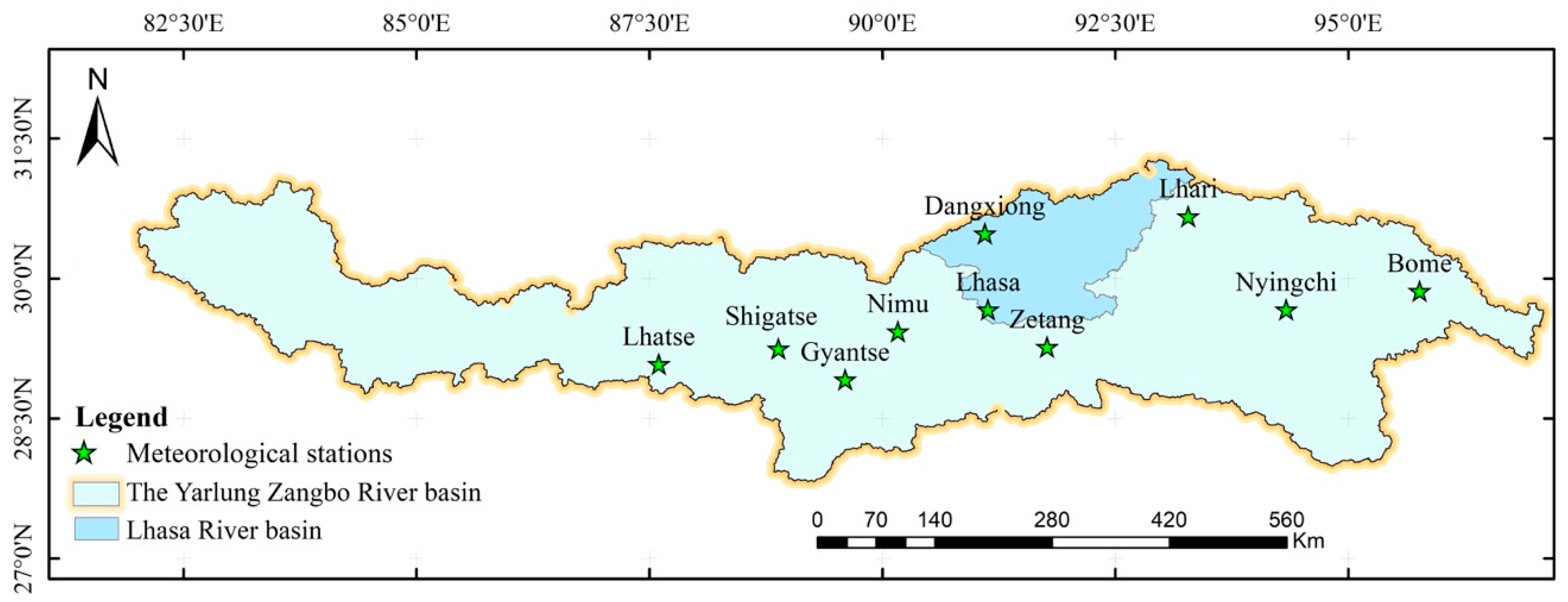

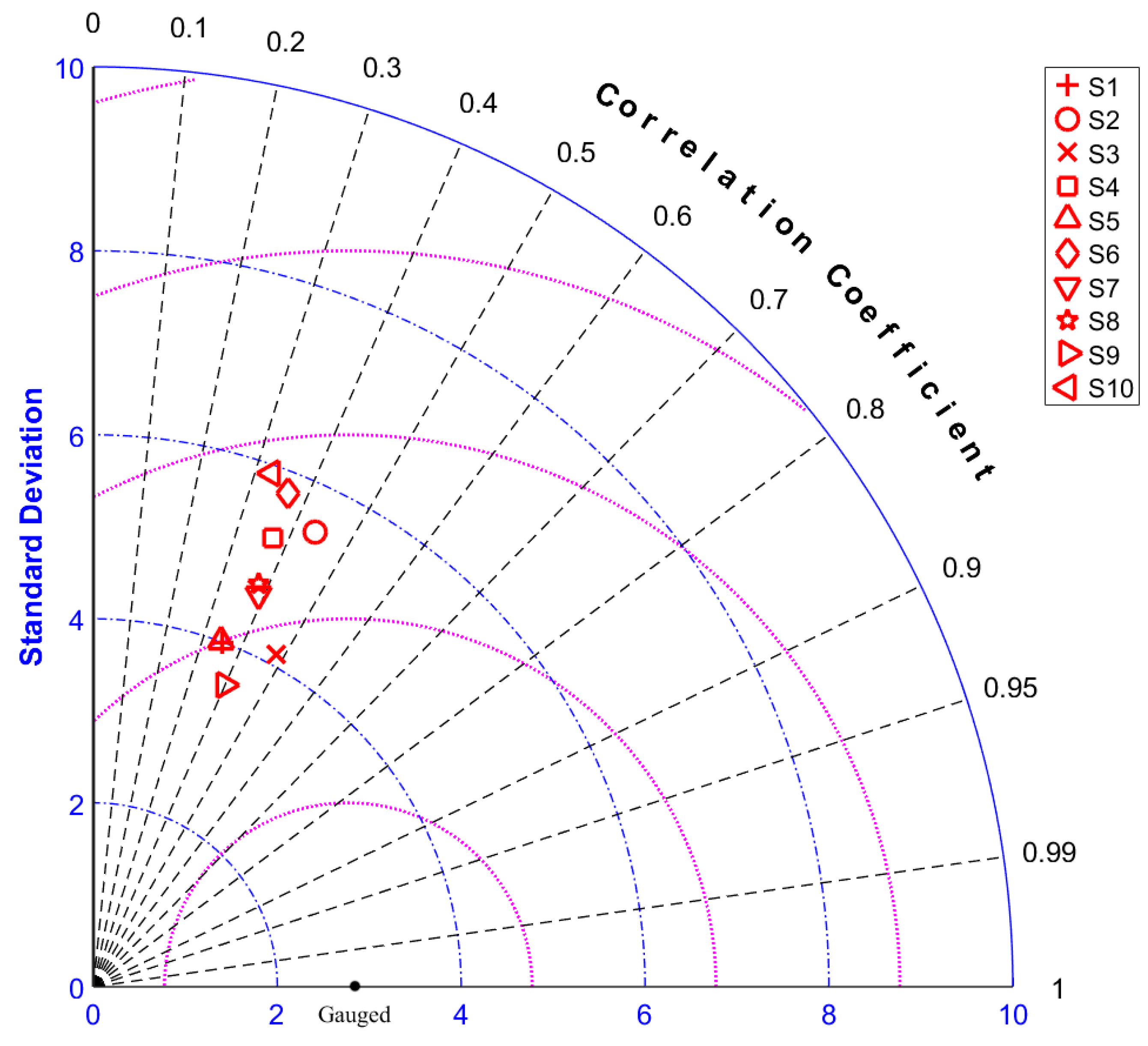


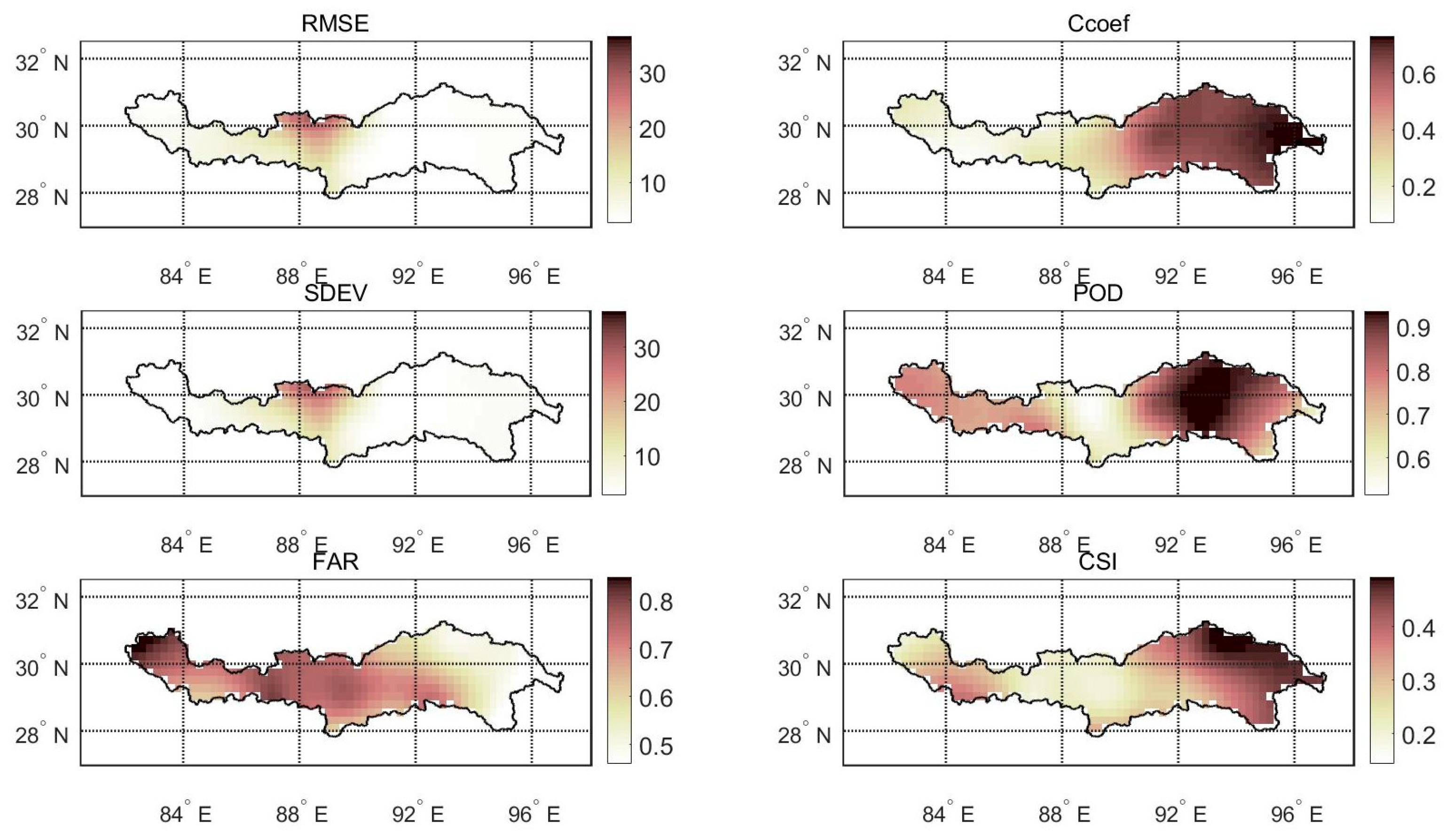
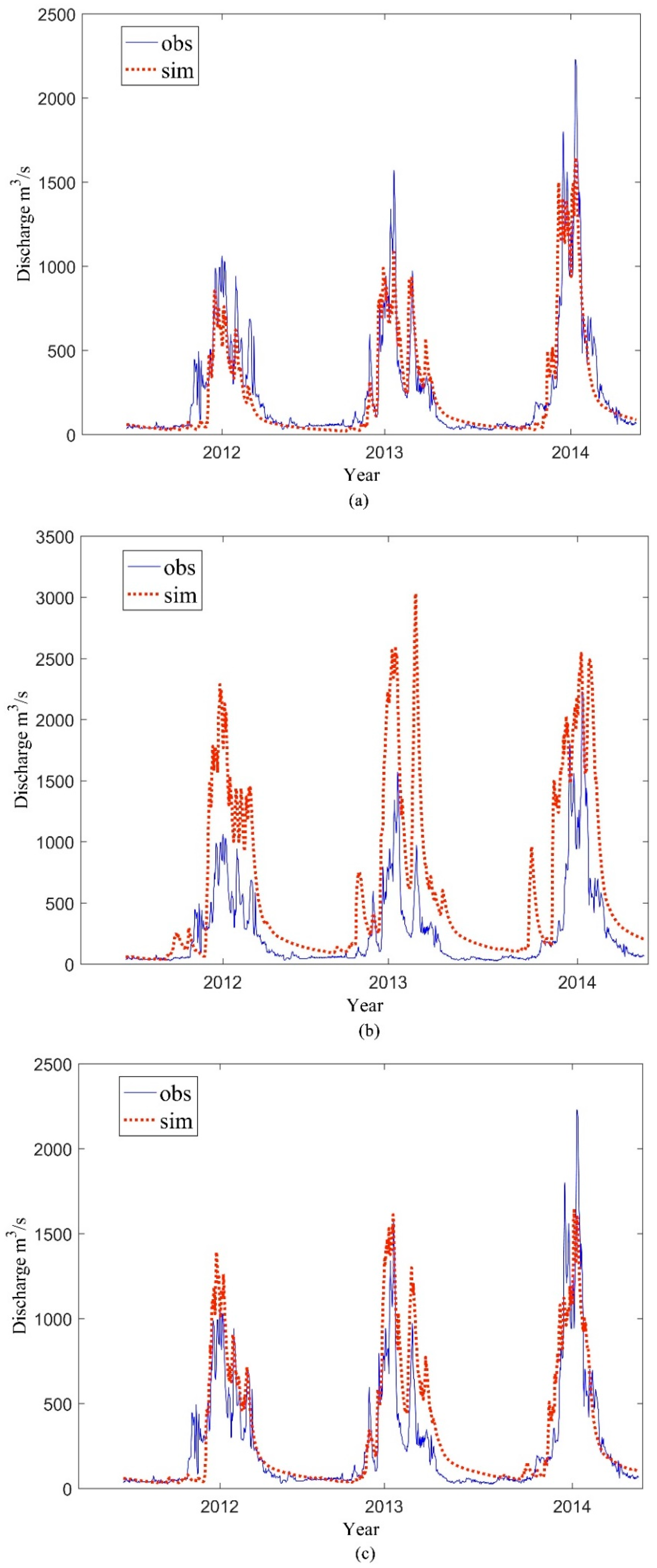

| ID | Station | ID | Station |
|---|---|---|---|
| S1 | Gyangz | S6 | Nyingchi |
| S2 | Lhatse | S7 | Lhasa |
| S3 | Shigatse | S8 | Bome |
| S4 | Zetang | S9 | Dangxiong |
| S5 | Nimu | S10 | Lhari |
| Indices | Formula | Range | Perfect Value |
|---|---|---|---|
| Cagegory1 (Basic Statistical Indices) | |||
| Correlation coefficient (Ccoef) | −1~1 | 1 | |
| Root mean square error (RMSE) | 0~∞ | 0 | |
| Standard deviation (SDEV) | 0~∞ | 0 | |
| Category2 (Probabilistic Statistical Indices) | |||
| Probability of detection (POD) | 0~1 | 1 | |
| False alarm ration (FAR) | 0~1 | 0 | |
| Critical success index (CSI) | 0~1 | 1 | |
| SDEV (mm) | Ccoef | RMSE (mm) | |
|---|---|---|---|
| UCPC | 3.99 | 0.58 | 3.24 |
| Step 1 | 3.98 | 0.73 | 2.77 |
| Step 2 | 16.16 | 0.35 | 15.46 |
| Step 3 | 174.19 | 0.26 | 173.56 |
| Spatial Resolution | RMSE (mm) | Ccoef | SDEV (mm) | POD | FAR | CSI | |
|---|---|---|---|---|---|---|---|
| UCPC | 0.15 | 3.24 | 0.59 | 4.00 | 0.84 | 0.66 | 0.32 |
| 0.25 | 3.24 | 0.58 | 3.99 | 0.77 | 0.65 | 0.32 | |
| 0.35 | 3.24 | 0.59 | 3.99 | 0.86 | 0.66 | 0.32 | |
| 0.45 | 3.24 | 0.59 | 4.00 | 0.87 | 0.66 | 0.32 | |
| CPC | 0.15 | 3.71 | 0.70 | 5.02 | 0.93 | 0.60 | 0.39 |
| 0.25 | 2.77 | 0.73 | 3.98 | 0.91 | 0.58 | 0.39 | |
| 0.35 | 5.14 | 0.64 | 6.37 | 0.95 | 0.61 | 0.38 | |
| 0.45 | 9.22 | 0.54 | 10.31 | 0.96 | 0.62 | 0.37 |
© 2018 by the authors. Licensee MDPI, Basel, Switzerland. This article is an open access article distributed under the terms and conditions of the Creative Commons Attribution (CC BY) license (http://creativecommons.org/licenses/by/4.0/).
Share and Cite
Liu, J.; Xu, Z.; Bai, J.; Peng, D.; Ren, M. Assessment and Correction of the PERSIANN-CDR Product in the Yarlung Zangbo River Basin, China. Remote Sens. 2018, 10, 2031. https://doi.org/10.3390/rs10122031
Liu J, Xu Z, Bai J, Peng D, Ren M. Assessment and Correction of the PERSIANN-CDR Product in the Yarlung Zangbo River Basin, China. Remote Sensing. 2018; 10(12):2031. https://doi.org/10.3390/rs10122031
Chicago/Turabian StyleLiu, Jiangtao, Zongxue Xu, Junrui Bai, Dingzhi Peng, and Meifang Ren. 2018. "Assessment and Correction of the PERSIANN-CDR Product in the Yarlung Zangbo River Basin, China" Remote Sensing 10, no. 12: 2031. https://doi.org/10.3390/rs10122031
APA StyleLiu, J., Xu, Z., Bai, J., Peng, D., & Ren, M. (2018). Assessment and Correction of the PERSIANN-CDR Product in the Yarlung Zangbo River Basin, China. Remote Sensing, 10(12), 2031. https://doi.org/10.3390/rs10122031





